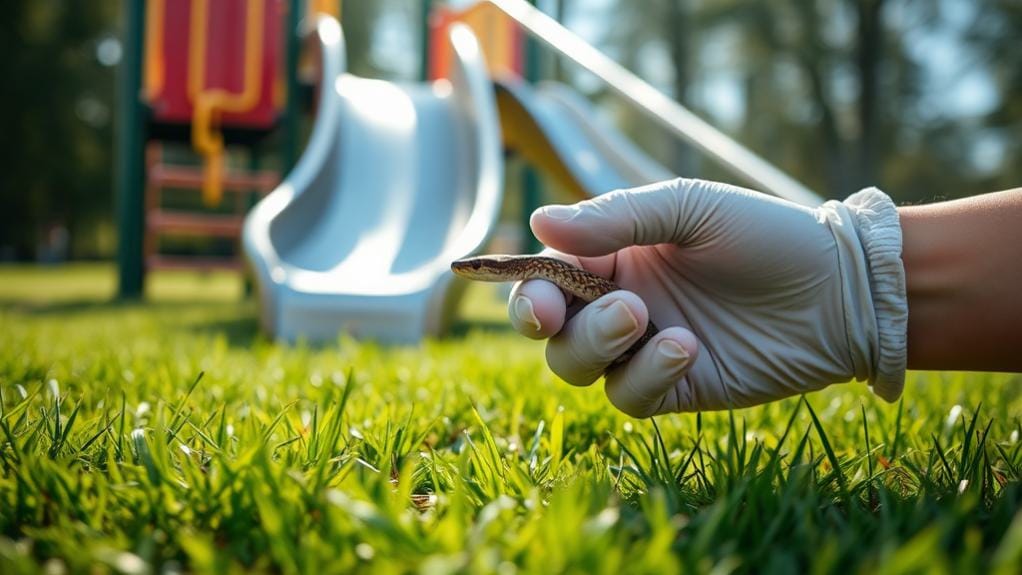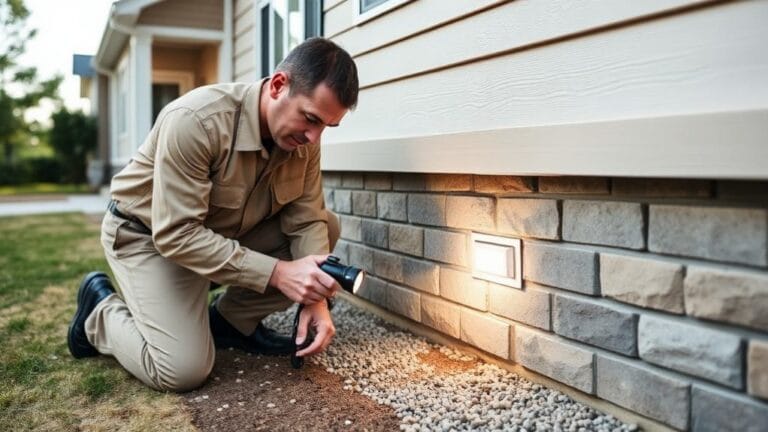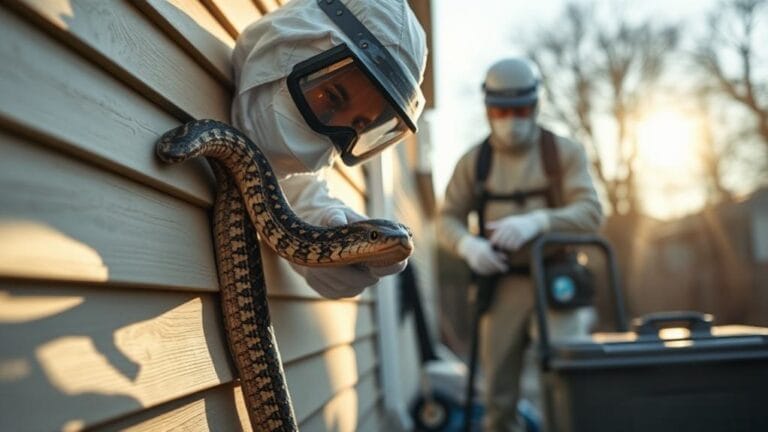Let's be clear – if you spot a snake at your kids' playground, don't panic and don't play hero. Keep your kids calm and back away slowly. No running, no screaming, and definitely no trying to catch it (seriously, what are you thinking?). Get everyone a safe distance away, then call your local wildlife authorities – they're the pros who won't end up in the ER. While you wait, keep an eye on the snake from a distance and make sure other families stay back. Most playground snakes are harmless, but it's not worth risking a bite to find out. Stick around to discover the smartest ways to prevent these scaly surprises.
Keeping Children Safe Around Snakes
Table of Contents
Anyone who supervises children at playgrounds in snake-prone areas needs to prioritize snake safety education.
During winter months, snakes may seek warm shelter spots near playground structures and buildings. Even a harmless black snake can strike if it feels threatened – and trust me, your panicked kid running around like a headless chicken isn't helping the situation.
Let me make sure you've got the basics down:
- Get those kids proper closed-toe shoes. Flip-flops? Really? Not in snake territory.
- Teach them the stomp-walk technique. It's like a tiny parade that keeps snakes away.
- Train them to freeze like a statue if they spot a snake. No dancing, no screaming, no Instagram moments.
Pro tip: Role-play snake encounters with your kids. Yes, it might feel silly, but it's better than having them learn the hard way.
Remember: A prepared kid is a safe kid.
Identifying Common Playground Snake Species

Across playgrounds nationwide, five snake species commonly make their presence known.
Let me tell you – it's really hard to spot them sometimes, but knowing what you're looking at can save you from unnecessary panic. While natural deterrent options like planting marigolds around playground areas can help keep snakes away, it's still important to know what you might encounter.
You'll likely encounter the Eastern Garter Snake or Black Racer.
Don't freak out – they're harmless and would rather run from you than fight. Trust me.
The Western Diamondback Rattlesnake? That's a different story.
If you hear that rattle, back away slowly. No heroics needed.
Pro Tip: *Look for the friendly faces first – the bright green Smooth Green Snake and the dramatic Hognose Snake (yes, the one that plays dead like it's auditioning for Broadway). They're your playground's natural pest control team.*
Emergency Response Steps

When faced with a snake at the playground, your immediate response can make all the difference in keeping everyone safe. Let's get real – this isn't the time to play Steve Irwin or test your snake-charming skills.
| Action | Why It Matters |
|---|---|
| Stay Calm | Panic = Bad Decisions |
| Back Away Slowly | Gives Snake Escape Route |
| Control Children | Prevents Chaos & Screaming |
| Call Authorities | Expert Help is Best |
| Monitor Snake | Keep Others Away |
Look, I know you want to be the hero, but unless you're a certified snake handler, your job is simple: protect the kids and call for backup. Keep everyone still (yeah, I know – getting kids to freeze is like herding cats), and maintain a safe distance.
*Pro Tip: Save the local wildlife authority's number in your phone now. Trust me, you won't want to Google it while staring down a snake.*
Teaching Snake Awareness

Teaching kids about snakes doesn't have to be scary – in fact, it's one of the best ways to prevent playground panic.
I'll show you how to turn your little snake-fearer into a confident nature explorer. Teaching them about natural snake predators like foxes and hawks can help reduce their fears while building their understanding of nature's balance.
Start with these proven approaches:
- Show them pictures of local snakes (Yes, the non-scary ones first. You're not trying to traumatize them.)
- Get them engaged with snake stories and books (They'll actually love this part)
- Let them role-play snake encounters (Think of it as their Oscar-worthy performance)
Pro tip: Don't skip the ecological chat. Kids are surprisingly interested in learning how snakes keep those pesky rodents in check.
Make it an open conversation. Let them share their fears – trust me, everyone's got that one dramatic snake story.
The more you talk about it, the less frightening those playground encounters become.
Proper Snake Handling Equipment

The right equipment makes all the difference between safe snake handling and unnecessary risks. I'll tell you what you absolutely need – and no, your gardening gloves won't cut it! You're dealing with wildlife here, not your petunias.
For the most humane approach, consider using professional snake tongs which allow for careful handling without harming the snake. You're dealing with wildlife here, not your petunias.
- Snake hook – It's your new best friend for keeping those fangs far from your fingers
- Heavy-duty gloves – Because bandages are so last season
- Ventilated container – Give your slithery friend some breathing room during transport
- Snake bag – Trust me, a grocery bag isn't going to work here
- Snake-specific first aid kit – Because "hoping for the best" isn't a medical strategy
*Pro tip: Keep all this gear in one designated spot. You won't have time for a scavenger hunt when there's a snake doing laps around the monkey bars!*
Signs of Snake Stress

When dealing with snakes, expert relocation services can provide professional guidance and safe removal. Remember to keep your distance until help arrives.
- Rapid tongue flicking: That's snake-ese for "I'm nervous!" Time to give them space.
- Tight coiling or flattened body: They're getting ready to defend themselves. Not good.
- Head hiding or escape attempts: They're begging you to leave them alone. Listen.
- Quick, jerky movements or strike attempts: Yeah, that's a clear "get lost" message.
- Hissing: If you hear this, you've really pushed their buttons.
*Pro tip: If you see ANY of these signs, slowly back away. No playground adventure is worth a snake bite – and an angry snake rarely gives second chances.*
Local Wildlife Authority Contacts

Your community's wildlife authorities stand ready to help with snake-related concerns at local playgrounds.
Before you start running around like a headless chicken at the sight of a snake, grab your phone and save these essential contacts.
Trust me – it's way better than trying to handle it yourself and ending up as a viral video sensation.
- Check your city's wildlife department website for their emergency hotline
- Save local snake removal specialists' numbers in your contacts (yes, right now)
- Look up your area's wildlife education center for prevention tips
- Download your region's wildlife authority app if they've one
- Join local wildlife alert systems or social media groups
*Pro Tip: Don't waste time googling "snake help" when you spot one. Have these numbers ready before you need them. Your future panicked self will thank you.*
Frequently Asked Questions
Are Snakes Safe Around Children?
I'll tell you straight: while most snakes aren't dangerous, I recommend teaching kids snake safety. When children learn to respect snakes and maintain distance, they're generally safe. But adult supervision's always important.
How to Handle a Snake That Has Never Been Handled?
I've learned through terrifying trial and error that you'll need a snake hook, calm movements, and patience. I approach at the snake's level, keep sessions brief, and watch for stress signals before touching.
What Not to Do When Handling a Snake?
I'll warn you: don't grab tightly, approach from above, handle stressed snakes, or corner them. I strongly advise against handling venomous species unless you're trained. These actions can trigger dangerous defensive responses.
What to Do if a Snake Approaches You?
If a snake approaches me, I'll stay calm and avoid sudden moves. I'm going to stand still until it moves away. Once it's gone, I'll slowly back away to maintain a safe distance.
Last Word
Look, I know you're thinking "I'll just grab that snake and fling it over the fence." Bad move. I've shown you the right tools and techniques because I want your kids safe. No one needs a snake bite story at the next PTA meeting. Call the experts I've listed – they're literally paid to handle this stuff. Meanwhile, keep those little hands away and those eyes alert. Your playground hero moment isn't worth the risk.








